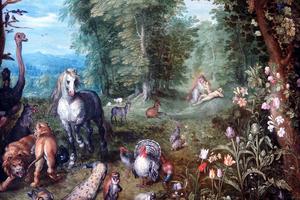The Fruitful Complementarity of Man and Woman
An interview with Sister Mary Prudence Allen, author of ‘The Concept of Woman.’

Sister Mary Prudence Allen is a religious Sister of Mercy of Alma, Mich. A philosopher by training, she is the author of a multivolume scholarly work on “The Concept of Woman.”
In September, Pope Francis appointed Sister Mary Prudence to the International Theological Commission, where she is one of only five women on the commission. Formerly the chair of the philosophy department at St. John Vianney Theological Seminary in Denver, she’s now a part of the chaplaincy team at Lancaster University in England.
This week, she presented at the Vatican-sponsored Humanum conference on the complementarity of man and woman. Sister Mary Prudence spoke with Register Vatican correspondent Edward Pentin about the conference, the uniqueness of marriage and common misunderstandings about gender.
It would be interesting, first of all, just to hear what your expectations were for this conference and whether you think it has been going as you’d hoped.
I didn’t have any specific expectations. I just came eager to listen to different peoples’ perspectives on the same topic of marriage. It’s always been a wonderful experience to find so many people of so many different faiths really agreeing about what marriage is and ought to be in general. You know, each tradition may interpret that in some unique ways. But by in large, it’s the basics, that marriage really — in all these traditions — is between one man and one woman, for the good of the family and the good of the spouses.
Though it’s such a common belief, a common awareness, would you say it’s still not discussed enough and that’s why this conference is so important?
Right. And I think it’s been highly threatened by legal — particularly — and ideological cultural forces trying to say marriage is just a certain kind of commitment between any two persons — it could be same-sex or some argue they could extend it to anything, really. I think it’s a wonderful thing to at least begin to open up [the discussion on] why the marriage of a woman and man is so special, what makes it different than just two individuals.
It might be difficult to answer this, since you’ve written so much about the philosophical concept of the complementarity of the sexes, but how would you define the complementarity of a man and a woman to someone completely unfamiliar with the idea?
The four essential characteristics of complementarity of woman and man are: first, equal dignity; second, significant difference; third, synergetic relation — meaning something more happens when you have two — a man and a woman together. It could be the generation of a child with God or it could be something more in terms of spiritual generation, like the example we just saw on the video of the family that began to incorporate all the kids from gangs. It’s generating something more than just the number of individuals. The fourth characteristic is what I call intergenerational fruition — meaning, it goes generation after generation after generation. Only the man/woman relation does that.
These four principles are in the Book of Genesis. Each one is clearly stated. God created us in his image — that’s equal dignity. He created us male and female — that’s significant difference. He sent us forth to marry: Be fruitful and multiply [that’s synergetic relation]. And then [intergenerational fruition] from the book of generations — that’s Genesis 5 — that goes from Adam to Noah. We start to see how history gets recorded. So each one of us, in a way, now is a part of the book of generation in our own family.
Now, if the person we’re talking to has no faith, then you’d have to use examples from science. And those are there, too, especially today, now that science understands how conception occurs. So you could say at the level of biology, when a mother and father, a man and a woman contribute to generation, they both have the same number of chromosomes and the same kind, in the sense that they are human. But the two of them are different. There is a significant difference between XX and XY [chromosomes]. And there is also a significant difference in the way they come together. A woman generates in herself. A man generates in another. Then the relationship is synergetic, not always every time, but it has the potential, actually with the help of God. Or, if they don’t believe in God, if they will think it’s their own doing, if there’s a fertile period, [it is there privilege] to basically participate in bringing a new human being into existence. And, obviously, it’s intergenerational, because they have fathers and grandparents and nephews and children, grandchildren.
What are the most common misunderstandings about gender?
There are lots of them. The most common are part of what I call gender ideology, which sprang up in the 1900s. It was mingled with the sex ideology of Alfred Kinsey, who basically reduced the human person to an animal-like quantum sex outlet, as he called it. That’s what was important — a sex outlet, reducing the human person to an animal.
And then John Money, who was working with surgeons and other medical professionals to basically make a person become whatever they wanted to be, using surgery and medical intervention. He understood the human person to be a kind of fragmented collection of parts, which could be put together in a kind of fluid way between birth and the age of 2. Now, both Kinsey and Money did research that was highly suspect and now people know [that what they found] are actually fraudulent results. But the difficulty is that their theories got incorporated into social-science textbooks, and people thought they were true. They then became the base of what is gender ideology — that there can be 5, 10, 15, and now I’ve heard there are 58 genders on Facebook, which is just not true. It’s not true. But it can make normal, average people a little bit insecure, wondering if they’re being somehow rigid in thinking that there are basically two — a male and a female.
Would you say that that’s the crux of it, in a sense: that the world’s being fed a lie about how men and women are? That complementarity is essentially the truth of relationships between men and women?
I do think so, myself. Because I think if you think of the whole being, the woman and man — it’s not just biological, but it’s the whole being — are two ways of being the human person. There always are some exceptions in organic nature, there are always going to be. But the lie is that the claim of the ideologist is that the exception is the norm. And it is not.
And that’s the big lie.
That’s the big lie. There are exceptions, and I think people suffer personally tremendously from them. That’s true, too. But they’re just exceptions, in the sense that they’ve always been an exception to the law. Just like a married couple that is unable to conceive and is infertile. They are exceptions to the normal, developmental capacities, but they’re still married — if they’ve made a covenant with one another, a promise.
And what happens when one ignores this truth about the complementarity of man and woman?
I think a big problem that especially I’m concerned about is when textbooks in schools for children in the latent period — between 8 and 13, let’s say — suggest that you could marry your best friend; you could marry whatever. During the latent period, your best friend is always same sex. Girls like girls, and boys are yuck, as we say; boys like boys, and girls are yuck. That’s normal and natural, but if you begin to plant the seed in the mind that you could decide who you want to marry — and it could be the same sex — and you think, “Well, my best friend is same sex,” then you might really start experimenting sexually, in ways that become habitual. It can actually lead — in a Catholic sense — to losing your vocation, which could be marriage or priesthood or the religious life. That’s a huge danger. If parents say nothing, then all those textbooks are being promoted, and in the media those kinds of things are [too]. Then it’s a big problem.
Sister Teresa Benedetta of the Cross (Edith Stein) wrote about complementarity. Is there anything you’d like to comment about her contribution to this debate?
She really was a very rich phenomenologist. She studied the phenomena of human experience. So in her studying she recognized that women tend to have a disposition to pay attention to the whole person in their environments. Men tend to have a disposition to be detached, and what they create is their projects — their work projects. This is just a tendency, not a biological determinism.
But John Paul II picked up that thought and then developed it into his theory of the genius of women and [his writings on what] men are like. [For example] St. Joseph, when he was told that this was what the Lord wanted — to adopt this woman and take this child as his own — he made an act of will. He became the father of Jesus and a husband to Mary. Then [we understand] the propensity of a man is to provide and to protect and defend them. The woman’s propensity, then — as John Paul II says — is to receive the people that are entrusted to her — like a pregnant woman receives and fosters the growth of a child within her; or a teacher in her classroom or a doctor with her patients. And [they strive] to foster their growth as whole persons. Those tendencies are true, and they’re there.
But being human, we have a free will, an intellect. We can always act against the tendency. So we’ve just seen these videos of men who leave their families — just go off on their own. That’s a decision to act against that tendency. Or in the case of a woman who has an abortion, she’s acting against that tendency to foster the growth of the child within her. Or even women who repress ovulation unnaturally, in some way, that’s acting against that disposition, too.
That’s Stein’s great work. [Karol Wojtyla] knew about her work; then, when he became Pope [John Paul II], it became universal teaching of the Church.
Lastly, looking to the future, do you see people getting to know better the complementarity of man and woman? Do you think it’s a growing awareness?
I think it is among Jewish and Catholic people who are becoming aware of it as a theory promoted universally by Pope John Paul II — I call him the apostle of complementarity for woman and man because he’s the first to give a complete integrated theory of that for men and women. It’s astounding what he did, [especially through] his audiences on the theology of the body and then in his St. Joseph [dialogue] through the Guardian of the Redeemer. They are now official Church documents for the whole world. So those who are interested and study those documents are quite excited about them. But it takes time for people to try them out.
Edward Pentin is the Register’s Rome correspondent.
- Keywords:
- complementarity
- edith stein
- edward pentin
- international theological commission
- john paul ii
- sister prudence allen

















